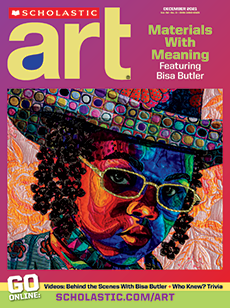Do any of the artworks on this page remind you of those shown in this article? Why or why not? Mexican artists today might find inspiration in Mexican history and culture. They might use symbols that have historical meaning. Or they might not.
Many contemporary Mexican artists explore visual vocabularies that relate to precolonial civilizations. But not all of them do. Art is about innovation, and that could mean building upon tradition or creating something entirely new. Art can reflect daily life or it can play with abstract ideas. Read on to learn how four Mexican artists are exploring art’s potential today.
Study the art on these pages. Does any of it visually connect to the art in this article? Many Mexican artists today find inspiration in history. Some explore themes and symbols from ancient Mesoamerica. Art is about experimenting. Artists can build on tradition or create something new! Art can reflect daily life, or play with abstract ideas. Read on to learn how four Mexican artists experiment in their work.
